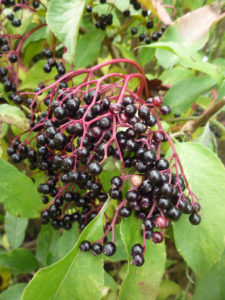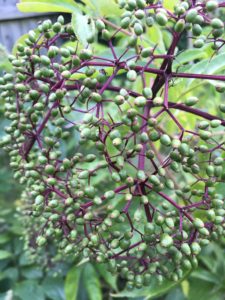-Kristin Weeks-

While grapes are, by far, the most commonly associated fruit with making wine, they certainly aren’t the only option. Here in the Southeast, where the terrain isn’t so ideal for growing grapes, we can instead turn to what is already growing right around us. One such plant that grows easily and in abundance in our region is the American elder (Sambucus canadensis), which bears purplish-black berries that come into season from July to late September, depending on where you live. As a result of having a natural balance of not-too-acidic, sweet, or tannic, these plump, little berries make a delicious wine that is every bit as good as that from grapes. The added benefit of making and drinking elderberry wine is its medicinal properties. The fruit has some of the highest antioxidant levels of any fruit. That alone is a great excuse to start making elderberry wine!

Perhaps you’re fortunate to have elderberries growing in your own backyard. If so, it’s likely that the fruit is beginning to ripen now (that is, given the birds haven’t gotten to them first!). Wine is best made using fresh-picked berries. However, it is possible to freeze them for later use. If you have an abundance of berries, set some aside for elderberry syrup– a powerful cold and flu fighting elixir– or jam. The flowers can also be used to make a delicious liquor. On a sidenote, Fall is a great time to plant fruit trees and bushes and establish your edible landscape.
Here at Fifth Season, we’ve witnessed a growing interest in home winemaking. We encourage folks not to be intimidated by, what is assumed to be, a difficult process. In fact, it can be quite simple! As such, if you’ve been considering trying your hand at making homemade wine, we recommend trying our basic elderberry wine recipe. This one is easy to make and hard to mess up!
Basic Elderberry Wine Recipe
Yields 1 gallon
Ingredients:
3 lbs elderberries
3 lbs sugar
1 gallon spring water
2 tsp. Acid Blend
1 tsp. Yeast Nutrient
1 Campden Tablet, crushed
1/2 tsp pectic enzyme
1 package dried champagne yeast
*Lalvin D-47, EC-1118, or 71B-1122
Red Star Premier Rouge or Montrachet
Directions:
- Pick elderberries at the peak of their ripeness. Wash, dry, and destem fresh elderberries. Alternatively, freeze elderberries after harvesting, then simply shake off the stem when ready to use. *Freezing for longer than a month is not recommended.
- Weigh the berries and prepare for processing. Place berries in a muslin or nylon straining bag and gently squeeze over a large pot to catch the juice. Wearing sterilized gloves, mash the berries without over processing.
- In the same pot with the elderberry juice, add water, sugar, and straining bag with elderberry pulp. Bring to a boil and allow to simmer for 15 minutes, then turn off heat.
- Once at room temperature, transfer liquid to a clean and sanitized, food grade, 2 Gallon Fermentation Bucket. Add acid blend, yeast nutrient, and 1 crushed campden tablet. Wait 12 hours then add pectic enzyme. Cover with clean towel and wait another 12 hours before moving on to the next step.
- Pitch yeast by sprinkling on top of liquid, then cover with grommeted lid and airlock, which allows CO2 to escape without allowing foreign particulate in. Allow to sit for 7 days. Most of the fermentation will occur in this time.
- After one week, remove the straining bag and carefully filter the liquid through a strainer into a 1 gallon glass jug, being sure to leave behind any sediment. Fit bottle with #6.5 drilled gum stopper and airlock.
- Leave wine alone for 4-6 months.
- When fermentation is complete, siphon finished wine into bottles. Cork, and store in a cool, dark room for several more months before enjoying.

Sonya Bevis's Wine Making says
When we think of wine we usually think about wines made from grapes. However, you can make wines that are very drinkable from many different fruits and berries. Some of the more common fruits used for winemaking are apples, pears, apricots, peaches, and plums. One of the things you have to be careful of when using fruits or berries is the variation in acid and sugar content you can get from year to year or the location that you source your produce. So using a hydrometer for sugar content and carefully testing the acid becomes even more important when making homemade wine from fruits or berries.
Hindberry Fruchtwein says
nice recipe, i use mostly different berries and fruits in one batch
cbd hemp flower sale says
Thanks for sharing useful information. keep sharing